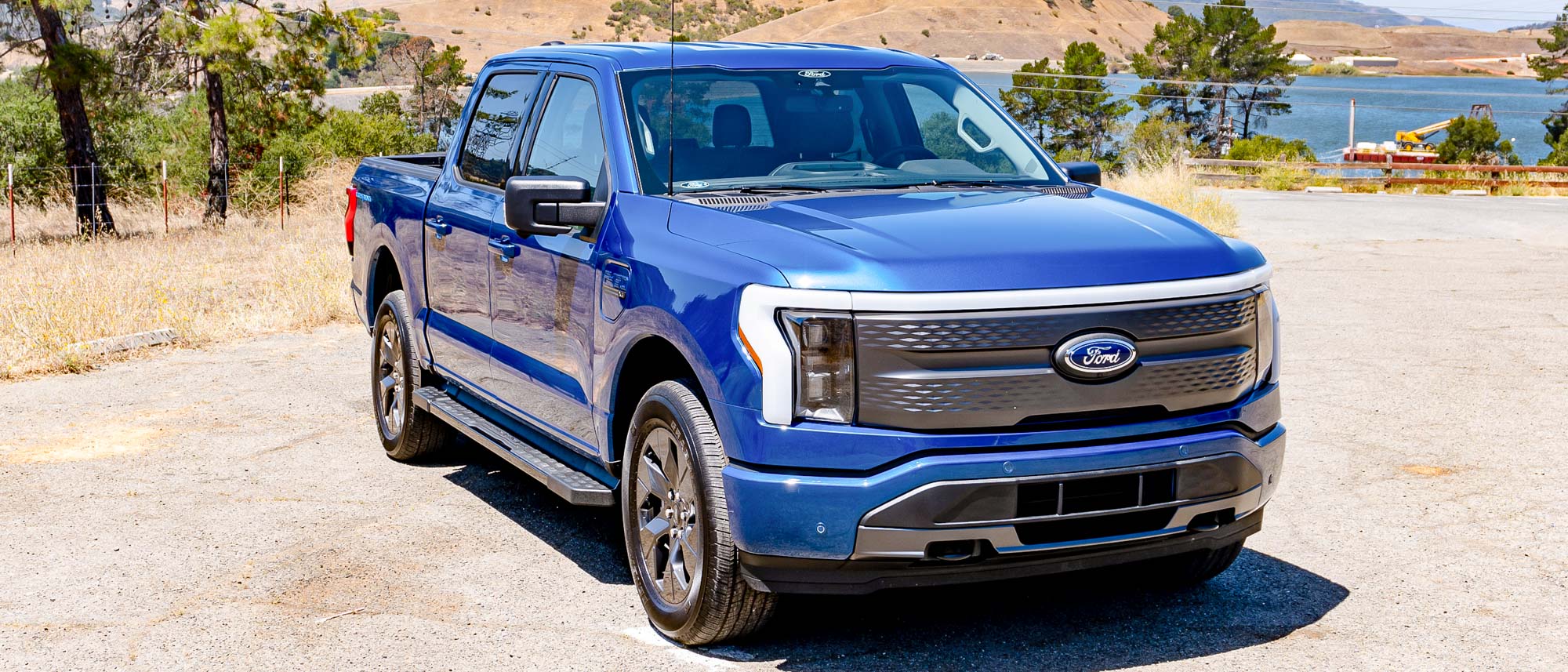Tom's Guide Verdict
The Ford F-150 Lightning is what happens when an automaker realizes that not all EVs need to be outfitted with clever features and minimalist interiors. Instead the company took a proven entity and actually improved upon it without diminishing what made it so popular in the first place.
Pros
- +
Impressive Range
- +
Vehicle-to-load support
- +
Best Driving F-150
- +
Compatible with legacy truck accessories
Cons
- -
DC Fast charges at 150kW
- -
Range destroyed by towing
- -
Paltry forward visibility
Why you can trust Tom's Guide
Release Date: Available Now
Price: Starts at $51,974 (Pro) $59,474 (XLT). Price as tested $80,974
Power: Dual Motor All-Wheel Drive
Horsepower: 452 (Standard), 580 (Extended)
Battery Range: 230 (Standard), 300-320 (Extended)
Top Speed: 105 MPH
0-60 mph: < 4 seconds
Smarts: BlueCruise, Sync, Wireless Apple CarPlay and Android Auto
If you haven’t heard yet, the Ford F-series of trucks has been the number one selling vehicle in the United States for decades. America loves its trucks, and especially. Many of those trucks are actually modern workhorses. They’re used by contractors, landscapers, farms, in large fleets, and are an important tool for many small businesses.
Ford transforming its number one selling vehicle into an EV doesn’t just give the automaker electric-vehicle cred, it’s part of a huge push by the automaker, and others, to electrify the fleet vehicles of the world. For the rest of us, it’s a way to satiate our desire for big American trucks. Going green shouldn’t interrupt our desire to sit above all the people in sedans.
The F-150 Lightning isn’t alone, and the electric truck market is the newest battleground of the auto industry. Every automaker seems to have an electric pickup on the horizon. It should end up as a crowded field, with all the hype around the segment, especially with the Tesla Cybertruck on the horizon. But the reality is that, right now, the Lightning’s main competitor is the Rivian R1T.
While both are pickups, they tend to appeal to different demographics. The R1T is geared toward the more outdoorsy truck buyer while the F-150 hits the traditional and business buyer.
To that end, the Lightning is available for both business and private customers. The less expensive (but business-centric) Pro model starts at $51,974, and for the rest of us it starts at just under $60,000. A huge price tag, but not that big of a deal for pickup buyers. In December of 2021, the average transaction price for a full-size pickup was $60,000. That’s the average amount people paid for a new truck in December 2021.
After a week behind the wheel of the F-150 Lightning, putting it through its paces as a pickup, we found the truck to be more than worthy of its name. In fact, this is likely the best F-Series truck on the market. It’s certainly the best F-150.
Thanks to an all-wheel-drive drivetrain and electric powertrain, the Lightning felt more planted to the asphalt than its gas counterparts and far smoother while driving around town and on the highway. In fact, it’s the best riding pickup on the market right now. Even better than the current king of pickup-ride quality, the Ram 1500.
The pickup is a treasure chest of technology that people will actually use. Power outlets are available everywhere and the vehicle’s ability to power a home from its battery pack is a huge draw for those that live in areas with frequent power outages. In addition to the cargo space in the bed, the Lightning’s frunk has enough space to store tools, groceries, and other items that a driver wants out of sight.
On the consumer side, the automaker’s Sync infotainment system is housed in either a portrait-oriented 15.5-inch touchscreen with a volume knob near the bottom of the screen or the standard 12-inch landscape display that ships with the XLT trim. Our XLT test vehicle had a 12-inch display and it was more than adequate for our needs. Regardless of display size, the system supports wireless Apple CarPlay and Android Auto.
Outside of some badging, the F-150 Lightning’s exterior is essentially the same as its gas counterpart. But despite looking like every other F-150 on the road, the Lightning delivers a better experience for most drivers. It drives better, has more cargo space, can power your home, and has an impressive range. Just don’t ask it to tow large loads for long distances.
Ford F-150 Lightning: Release date, pricing and trim levels
The 2022 Ford F-150 Lightning is available in four trim levels. The trim levels span the range from bare-bones vinyl seats without most of the fancy bells and whistles most truck buyers are looking for to the nearly $100,000 top-of-the-line variant. The two middle trim levels can also be optioned with the Extended Range battery pack. It comes standard on the Platinum and is only available to fleet customers on the low-end Pro model.

The fleet and business Pro model starts at $51,974. For the rest of us, the XLT trim level starts at $59,474. The mid-level Lariat starts at $74,474 and the high-end Platinum variant is just shy of $100,000 starting at $96,874. These prices do not include a $1,795 destination charge.
Adding the 131-kWh larger battery to the mid-level XLT and Lariat trims costs extra, ranging from $11,500 (Lariat) to and insane $21,500 (XLT), with the benefit being more range. The EPA rates our XLT test vehicle at 320 miles of range with the larger battery. In our tests, we secured 322 miles of range from the pack. With the standard battery, the EPA rates the vehicle’s range at 240 miles.
But you get more than range, since Ford throws in its Charge Station Pro as well. This home charger supports the bidirectional charging feature that allows the truck to power a home. The larger battery also has a faster onboard charger, charging at up to 19.2 kW compared to the standard battery’s 11.3 kW. Ford says that with the Charge Station Pro, the Extended battery pack can be charged from 15 percent to 80 percent in eight hours instead of 10.
The big question for buyers is if 80 additional miles of range, quicker at-home charging, and a charging station that supports powering your home are worth the additional $12,500.
Not so hot on the heels of GM’s Super Cruise, Ford has its own hands-free driver assistance system, BlueCruise. We’ve tested the system on other Ford vehicles and while it’s not as robust as GM’s offering, it’s getting better with each drive. Adding it to the Lariat trim F-150 Lightning costs an additional $2,200. It’s standard on the Platinum and not available on the XLT model.
Ford F-150 Lightning: Range, battery and charging
During our tests in a mixed environment of highway driving at 70 miles per hour and on suburban and urban roads, the Lighting generally exceeded its 320-mile EPA estimated range. Although, only by a little bit.
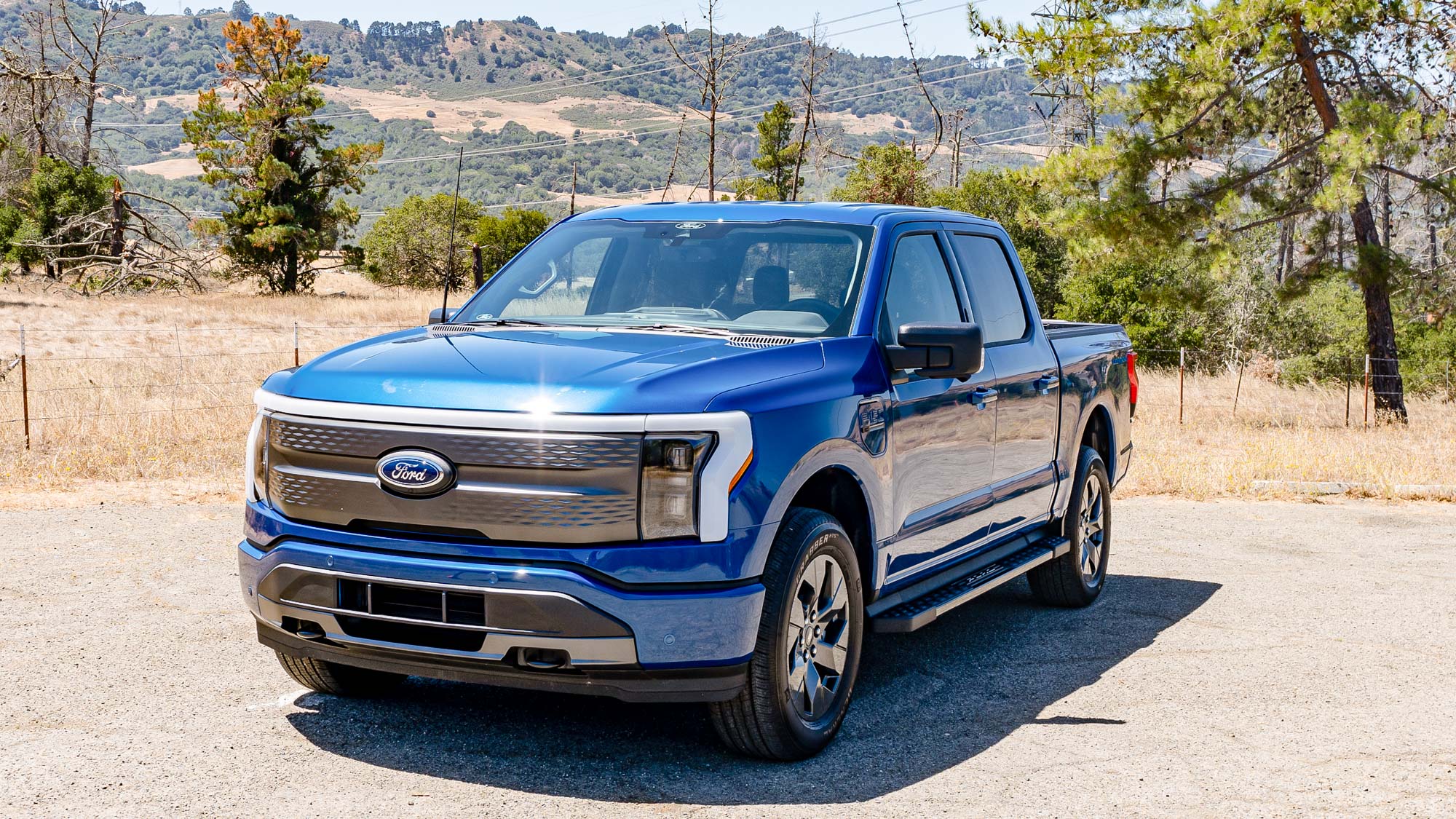
Our range test is a 50/50 combination of highway driving with very little traffic and surface street driving with usual mid-day traffic. The test was conducted on a day with mild weather (between 65 and 70 degrees) and with little to no wind. Based on our experience with other Ford EVs that have also met or slightly exceeded their EPA range numbers, we expect that the smaller 98 kWh Standard range battery will have no issues hitting its EPA-stated range.
Where things do get disappointing is Ford’s use of a 400-volt electrical architecture, which limits how quickly the Lightning can be recharged. All trim and battery capacity versions of the pickup support DC fast charging up to 170 kW. Considering the size of the battery packs, especially the Extended range version, 170 kW feels slow when you consider that the Hyundai Motor Group is outfitting its E-GMP vehicles with 800-volt systems with charge rates above 200kW.
Fortunately, level 2 charging for the Extended range battery is 19.2kW. For the regular battery pack, it’s 11.3 kW. So overnight charging of the Lightning shouldn’t be a problem with charging stations that can output that much energy.
F-150 Lightning: Interior and cargo space
The Lightning, like all modern full-size pickups, is massive. Head and leg room are far from any sort of issue for drivers and passengers, regardless of their location in the cab. If you can pull yourself up into the cabin, you’re going to have room to sit comfortably.
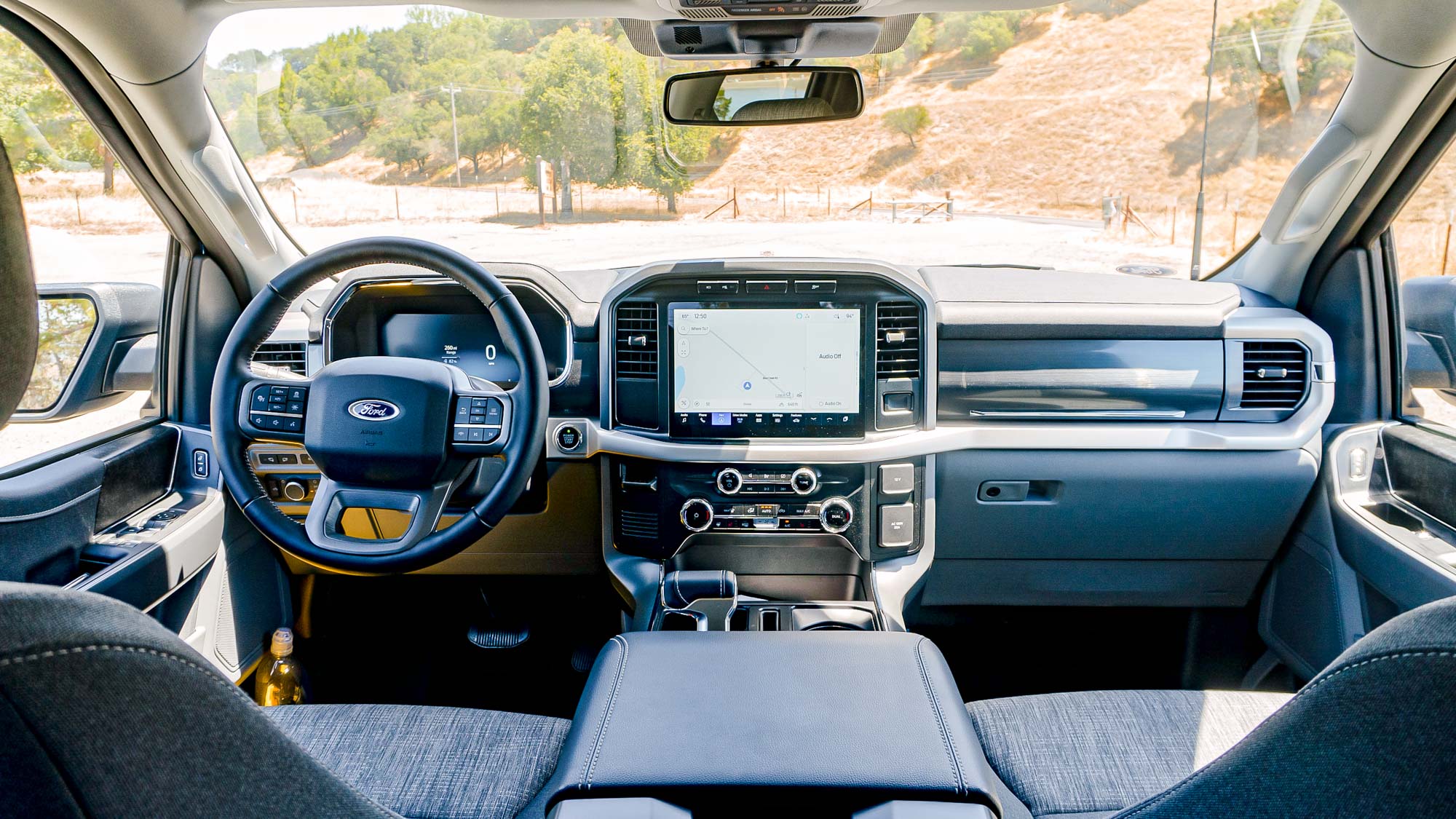
The interior is nicely outfitted but is exactly the same as you would find in the gas version of the F-150. Again, this is by design. Ford is not looking to show off some exciting minimalistic interior. Instead, it wants its customers to feel comfortable and the overall design consistency between the two powertrains does that.
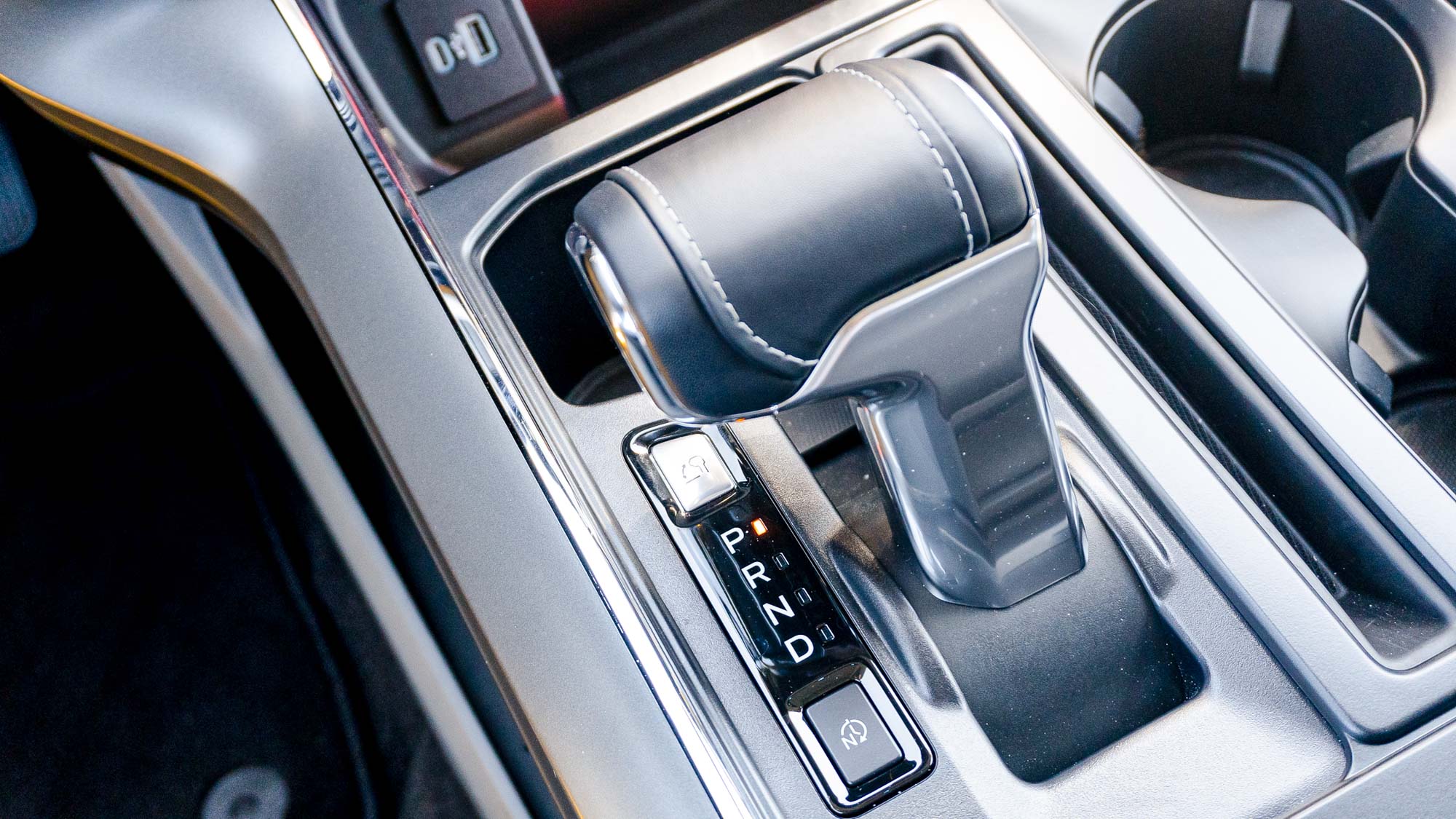
While the large portrait display will impress friends, the 12-inch touchscreen, complete with physical buttons for climate and media controls, is likely the better setup for most drivers. It’s easier and safer to use actual tangible controls for the things you do most while driving. This is especially true in a world where many drivers are using their smartphones as their infotainment system.
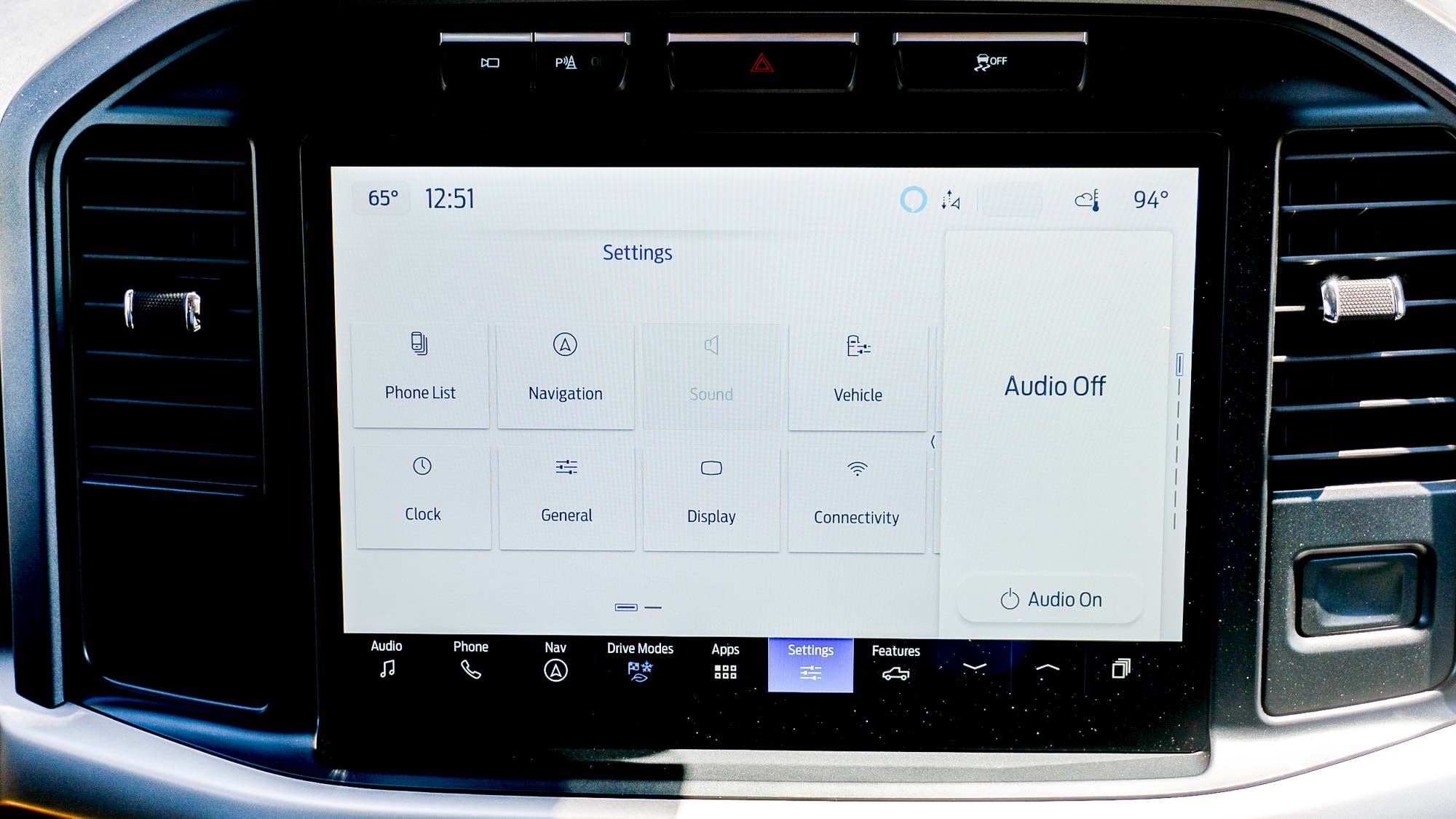
The seats themselves were comfortable, and both front and rear offer ample support for long drives. The quality of the interior is on par with other pickups. While the vehicles themselves now command luxury prices, they are still more geared for a utilitarian life. Overall, it’s exactly what you want from a truck in the XLT trim level.
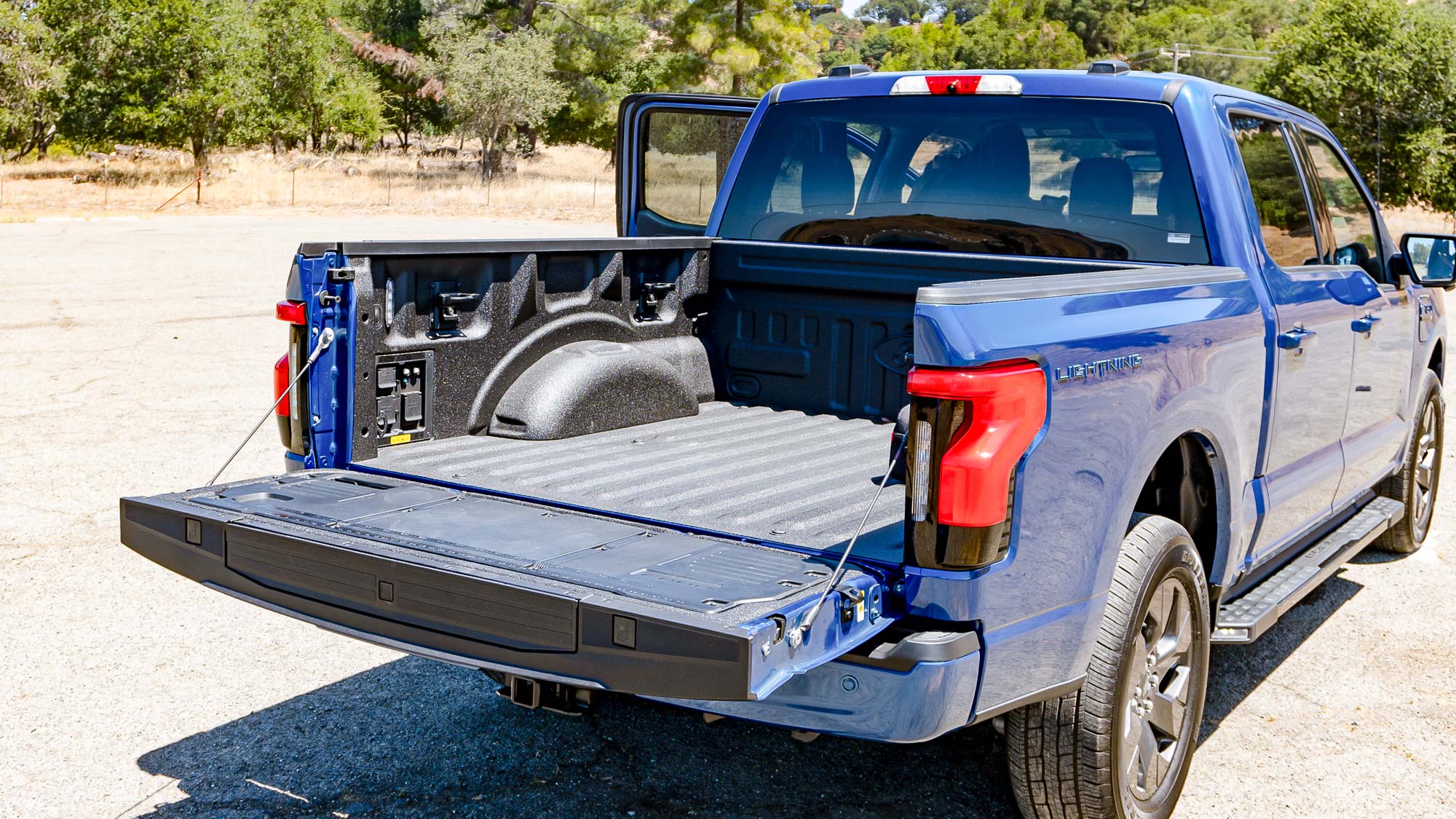
The Lightning is outfitted with the standard 5.5-foot bed., and those looking for a long-bed version of the electric F-150 will be disappointed. There’s plenty of room for 95% of what truck owners will do with their vehicles, but the real story is upfront.
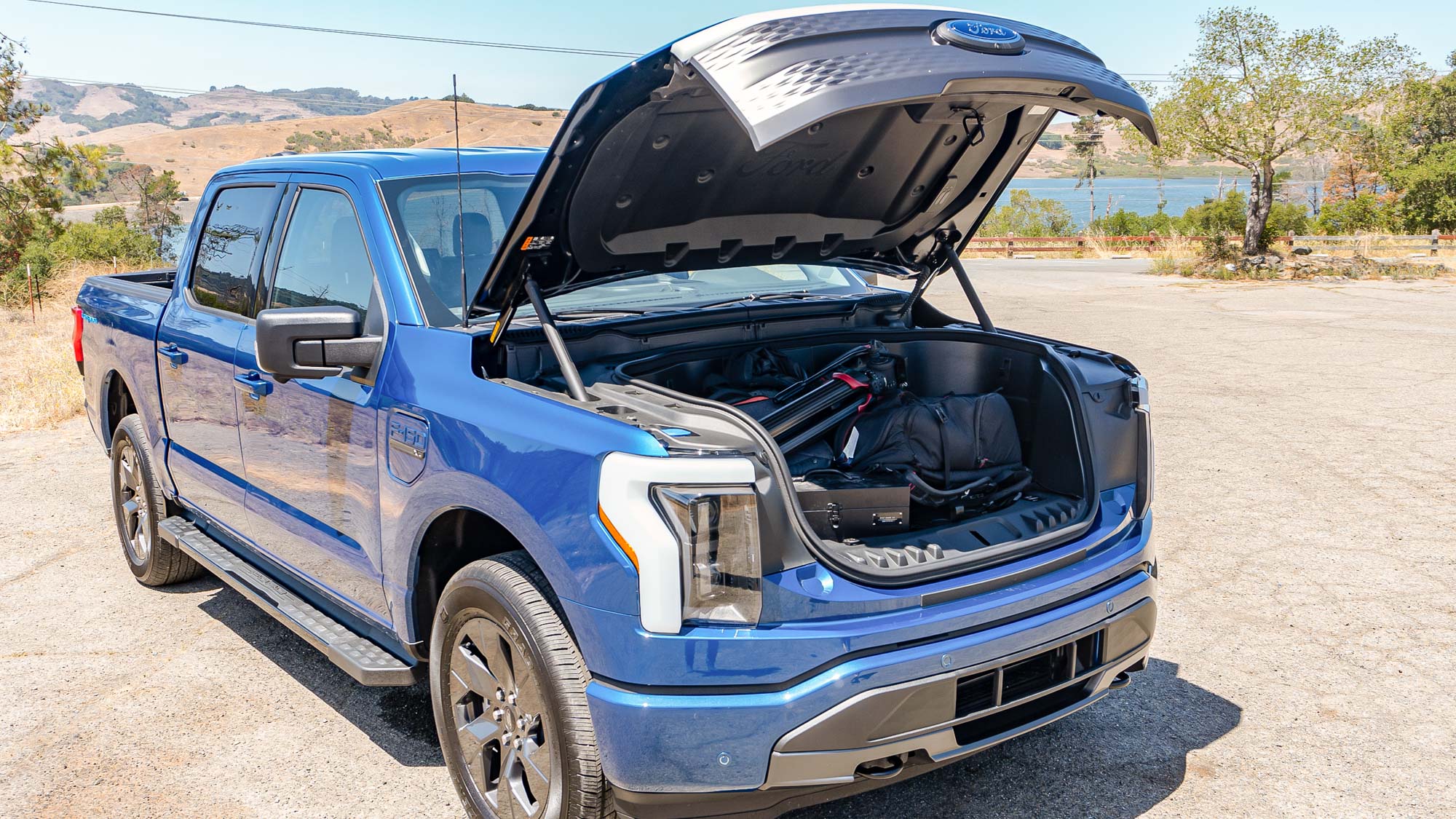
The F-150 Lightning has an enormous frunk, offering 14.1 cubic feet of space and the ability to hold up to 400 pounds. During a video shoot, we were able to shove tripods, tools, and multiple backpacks full of gear into the frunk and still have room for additional items. It even has a drain for those looking to fill a section with ice for tailgating and camping.
In addition to more space, it’s also somewhere to place items that you would want out of sight. Something that can be difficult with a pickup without a bed cover.
F-150 Lightning: Tech and safety features
While the Ford Mach-E is more tech-forward, Ford has made sure that any additional tech in the F-150 Lightning is welcomed by its long-time customers. That said, the infotainment system, outside of a few extra features that are EV-centric, is the same as you would find in the gas-powered vehicle.
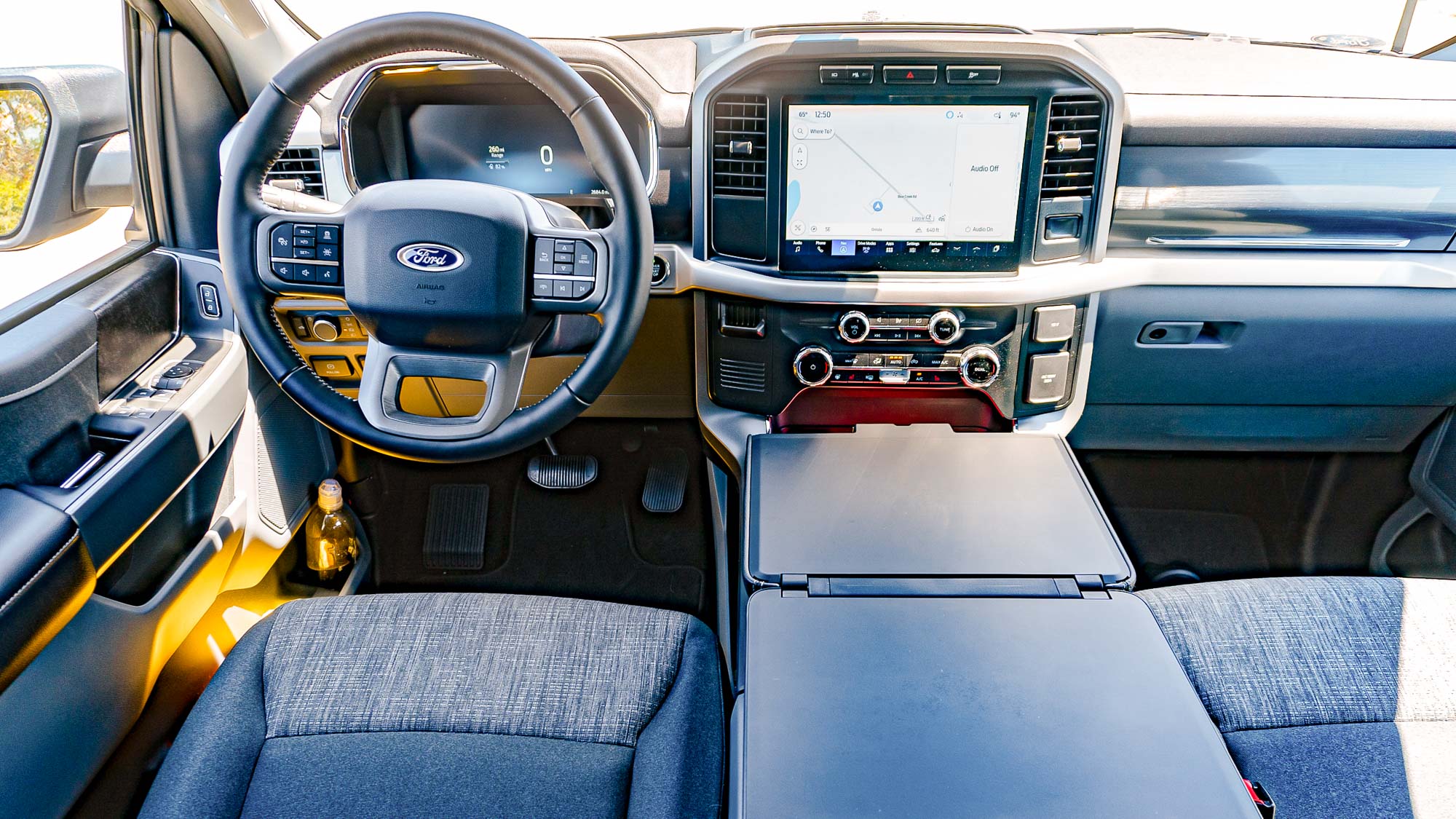
The real tech is more about the experience than something you poke at with a finger.
To make charging the vehicle less of a pain, Ford has teamed up with multiple charging providers including Electrify America to support plug and charge. Once someone merges their vehicle account with their charging provider account, they should be able to just plug the vehicle in without having to use a credit card or app to initiate charging. Some other automakers offer this convenience too, notably Tesla.
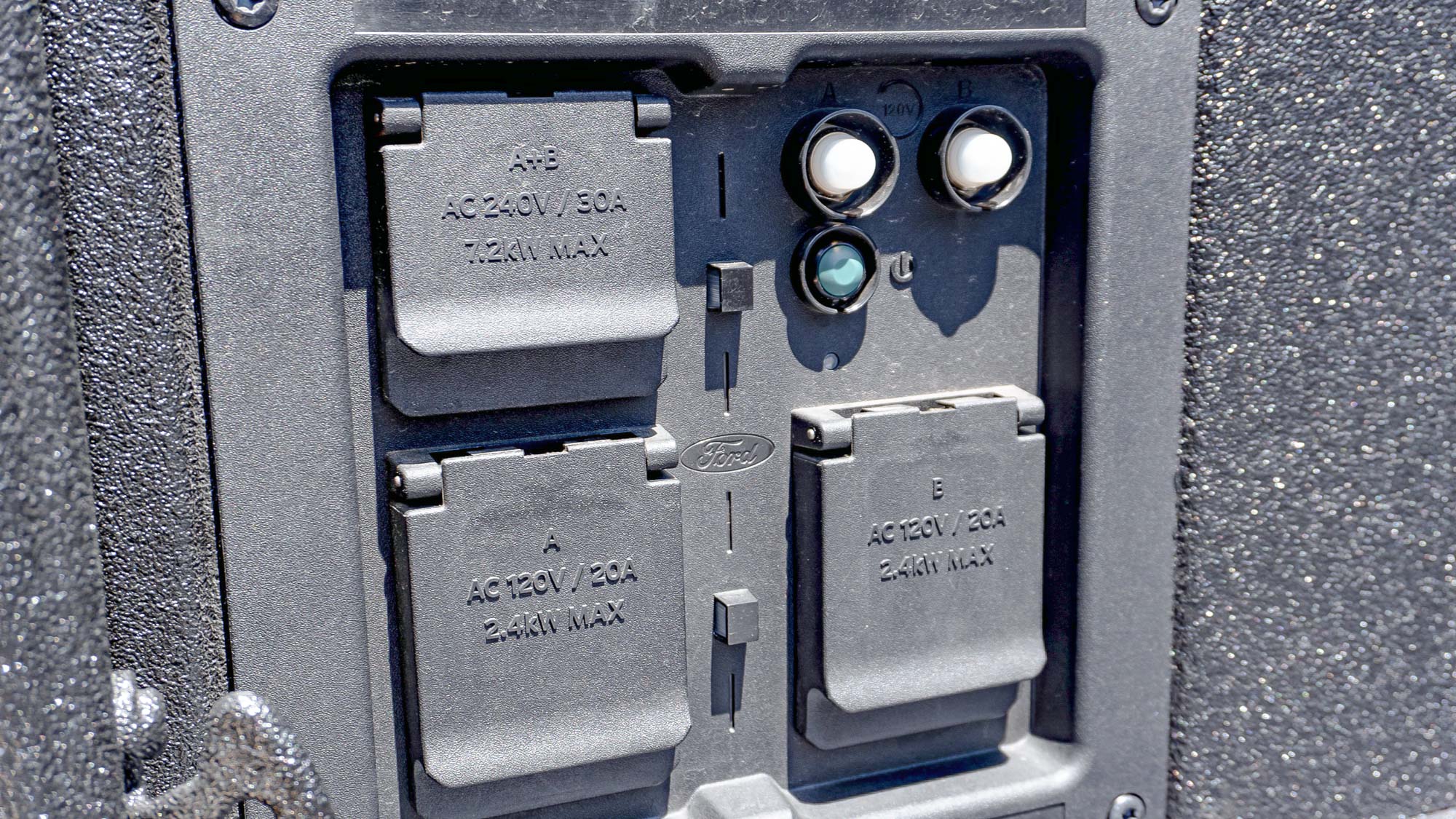
The electric powertrain also offers up opportunities for working on the go and keeping your lights on during blackouts. For those out in the field, the Pro Power Onboard can be used to deliver electricity to tools, lights, even other EVs with either 2.4 kW or 9.6 kW of power. Ford even threw in a few EV charging adapters in case you need to help a stranded vehicle, and we used it to charge a Ford Mustang Mach-E. Power is available in the bed, frunk and in the cabin.
More impressive is that the electric F-150 supports vehicle-to-load (V2L). It can be used to charge your home when coupled with a supported home charging station. For those that opt for the larger Extended range battery, Ford includes the station needed to make this a reality. If you live in a region with irregular power supply from utilities, the F-150 can replace at-home battery solutions like Tesla’s Powerwall.
As for the grid, Ford and California energy provider PG&E have begun a pilot program to determine how the Lightning can be used to help alleviate the pressure placed on the grid during high-energy usage days.
F-150 Lightning: The drive
The first time you press on the accelerator, you’re immediately hit with the realization that an electric powertrain makes the F-150 a far better pickup. The all-wheel-drive system reduces any of the typical wheel slip you’d experience on a rear-wheel drive truck.
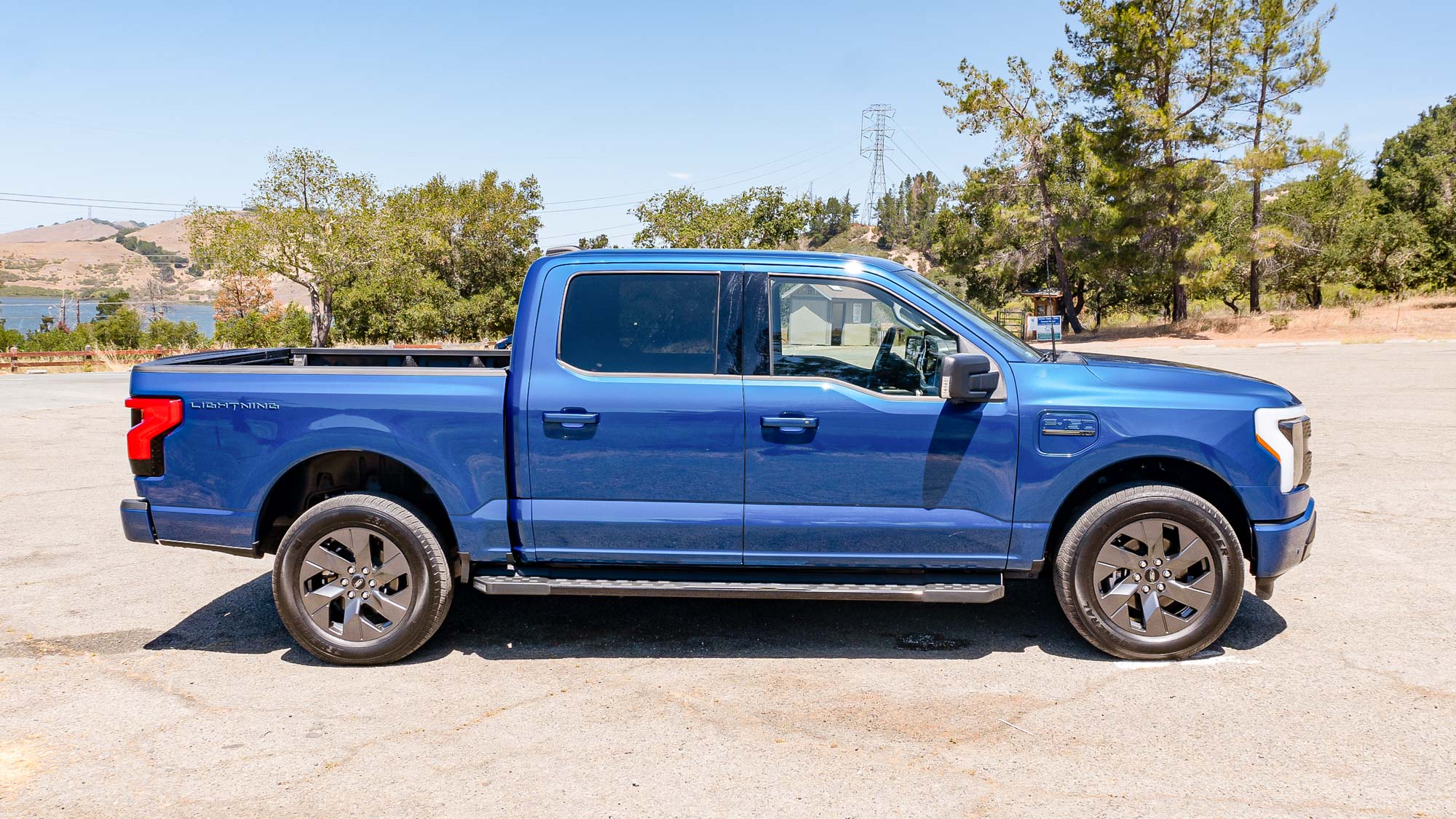
In addition to grabbing the asphalt more consistently, it also contributes to quicker acceleration combined with a more confident feeling of control over the vehicle. Steering isn’t as tight as the power delivery, but it’s far tighter than you would expect for a pickup.
The ride quality also gets an upgrade. Previously the best riding pickup was the Ram 1500 pickup. The Lightning with its low center of gravity and lack of engine vibration now beats it offering a smooth experience that when combined with the structural rigidity afforded to the body-on-frame pick by the inclusion of a large battery pack.
On the freeway and around town, as a large truck the Lightning is a delight to drive. On back roads, the tight corners do give way to the expected body roll of a large vehicle that’s housing a very heavy battery pack. Sure the pack lowers the vehicle’s center of gravity, but it’s still a tall beast of a vehicle and at some point, physics takes over.
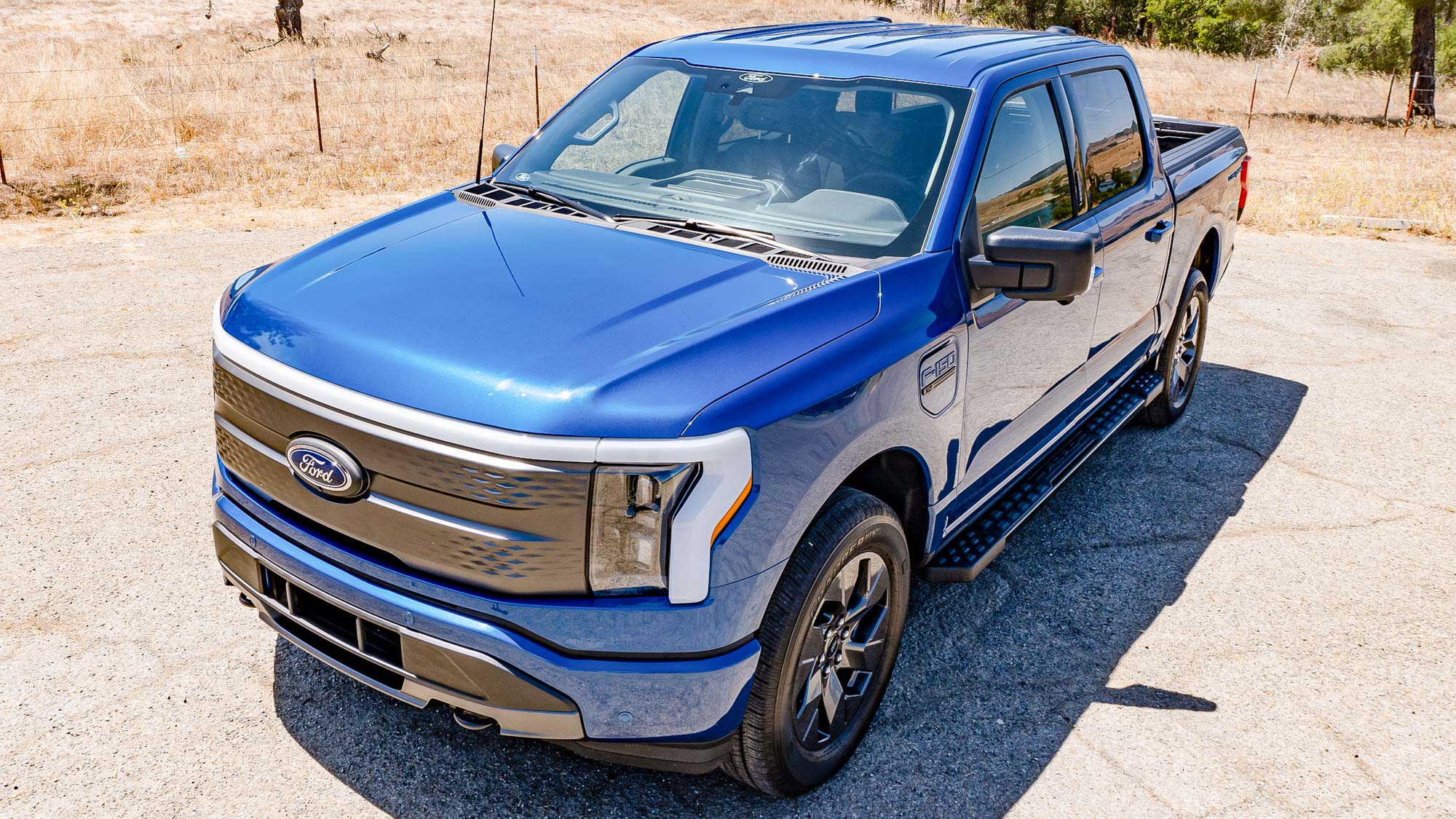
The biggest downtown is also an issue without the entire large pickup truck market and that’s lack of forward visibility. Current truck design includes a more squared off hood which reduces what you can actually see right in front of the Lightning. In parking lots, around town, in drive throughs, and in gridlock, it can be difficult to determine how close you are to smaller vehicles ahead of the pickup. I would have gladly given up a few cubic feet of space in the frunk for the ability to see what’s happening directly in front of the Lightning.
F-150 Lightning: Navigation and driver assistance features
On the road, the Lariat and Platinum versions of the vehicle support Ford’s BlueCruise hands-free driver assistance system. Our test vehicle was the XLT trim level so we were unable to test the system on the pickup. Although we have used the driver assistance system on the Mach-E and found it to be adequate but not nearly as robust as GM’s Super Cruise hands-free offering.
All three consumer trim levels come standard with Ford’s Co-Pilot safety suite that includes a 360-degree camera, cross traffic alerts, reverse sensing system, pre-collision assist with emergency braking, reverse brake assist, and lane keeping alerts. It’s a robust standard system that should give drivers additional piece of mind while driving the rather big vehicle.
Navigation and turn-by-turn directions are on par with offerings from other automakers. It’s likely not enough to get people to switch from Google Maps, but it gets the job done.
F-150 Lightning: Verdict
The F-150 Lightning is what happens when an automaker realizes that not all EVs need to be outfitted with clever features and minimalist interiors. Instead the company took a proven entity and actually improved upon it without diminishing what actually sells the vehicle.
In fact, thanks to the electric powertrain, Ford has introduced the best F-150 ever. It’s smoother, smarter, quicker, and has an insane amount of cargo space that you can actually hide from the public. It’s done this with the same body we see on the gas version which means all the attachments, cages, and other items that are available to bolt on to the gasoline F-150 will fit without issue on the EV version.
It’s really the best of both worlds which is exactly what Ford needed to introduce to the world. A work truck that is ready for work, but at the same time makes you feel better about your environmental choices with a little pampering thrown in for good measure.
